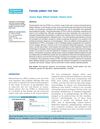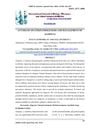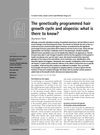TLDR Hair loss treatments for women are limited, with hair transplants being the only permanent option.
The document reviewed the therapeutic options for female pattern hair loss, highlighting the psychological impact of the condition and the challenges in treatment. It noted that only minoxidil and finasteride were approved for androgenetic alopecia, but they provided mediocre results and were not a permanent cure. Hair transplantation was the only permanent solution, though it required surgery. Other treatments, such as antiandrogens, prostaglandin analogs, and ketoconazole, were reported to be beneficial, while laser and light therapies gained popularity despite limited effectiveness. The focus of therapy was to manage expectations and aim to slow or stop disease progression rather than achieve permanent hair regrowth.
 23 citations
,
January 2013 in “Indian Journal of Dermatology, Venereology and Leprology”
23 citations
,
January 2013 in “Indian Journal of Dermatology, Venereology and Leprology” FPHL causes hair loss in women due to genetics and hormones; minoxidil and anti-androgens are treatments, and early intervention is advised.
 October 2023 in “International journal of biology, pharmacy and allied sciences”
October 2023 in “International journal of biology, pharmacy and allied sciences” Personalized treatment plans combining natural and synthetic approaches are important for managing alopecia effectively.
 198 citations
,
October 2011 in “Journal der Deutschen Dermatologischen Gesellschaft”
198 citations
,
October 2011 in “Journal der Deutschen Dermatologischen Gesellschaft” Use minoxidil for hair loss; finasteride and dutasteride for men, dutasteride for women.
 13 citations
,
January 2016 in “Journal of cosmetology & trichology”
13 citations
,
January 2016 in “Journal of cosmetology & trichology” Alternative treatments show promise for hair growth beyond traditional methods.
 3 citations
,
June 2006 in “Expert Review of Dermatology”
3 citations
,
June 2006 in “Expert Review of Dermatology” The document concludes that hair loss is complex, affects many people, has limited treatments, and requires more research on its causes and psychological impact.
 August 2025 in “Drug Design Development and Therapy”
August 2025 in “Drug Design Development and Therapy” Current treatments for androgenetic alopecia are complex and promising, but more research is needed.





